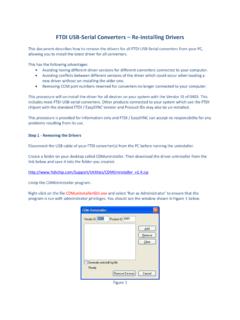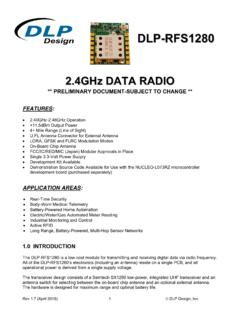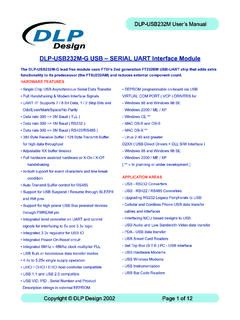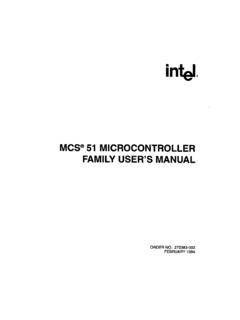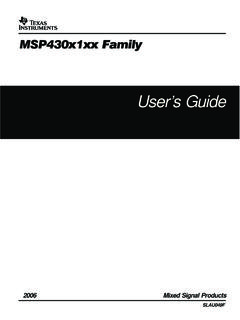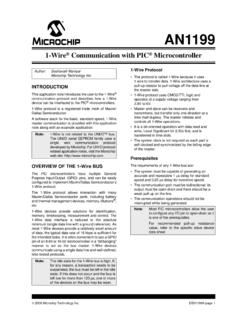Transcription of DLP-7970ABP
1 Rev (September 2013) 1 2013 DLP Design, Inc. DDLLPP--77997700 AABBPP BBoooosstteerrPPaacckk UUsseerr ss GGuuiiddee FEATURES: HF RFID Reader/Writer Compatible with the NFCLink Library Compatible with the MSP-EXP430G2X LaunchPad Compatible with the MSP-EXP430F5529LP LaunchPad Compatible with the C2000 LaunchPad Compatible with the TIVA C Series LaunchPad Compatible with the Hercules LaunchPad Supports ISO 15693, 18000-3, 14443A/B and FeliCa RFID/NFC Reader, NFC Peer or Card-Emulation Mode NFCIP-1 (ISO/IEC 18092) and NFCIP-2 (ISO/IEC 21481) On-Board Antenna FCC/IC Approvals in Place Operational Power Supplied by the LaunchPad INTRODUCTION The DLP-7970 ABP is an add-on board designed to fit TI s MCU LaunchPads that incorporates DLP Design s DLP-RFID2 RFID module.
2 This BoosterPack allows the software application developer to get familiar with the functionalities of the TRF7970A multi-protocol, fully-integrated, RFID/NFC IC on their Texas Instruments embedded microcontroller platform of choice without having to worry about developing the RF section. The NFCLink library is an industry-proven modular firmware/software solution that provides a programming interface for TI s family of TRF79XX NFC devices supporting the hardware level up through the host operating system via an API. NFCLink is a library of NFC and HF RFID firmware using the NCI protocol to communicate with a host OS or MPU. NFCLink currently supports MSP430 5XX and 6XX series devices. Visit the TI website for more details: This document provides direction for TRF79XX users implementing a RFID reader solution using the TRF79XX IC connected to a Texas Instruments embedded microcontroller or microprocessor development platform.
3 Examples of such development platforms are the MSP-EXP430G2 LaunchPad and the MSP-EXP430F5529LP LaunchPad. LaunchPads from Texas Instruments are easy-to-use flash programming and debugging tools for the MSP430, C2000, TIVA, etc. line of microcontrollers. They feature everything you need to start developing on a Texas Instruments microcontroller device. They have on-board emulation for programming and debugging, on-board button switches and LED s and BoosterPack-compatible pinouts to support a wide range of plug-in modules like the DLP-7970 ABP. Rev (September 2013) 2 2013 DLP Design, Inc. Free software development tools are also available, such as TI s Eclipse-based Code Composer Studio. Open-source development is also available thanks to community-driven projects such as the MSPGCC compiler or Energia, a branch of the popular Wiring framework.
4 SCOPE This document describes the DLP-7970 ABP module for evaluation and development purposes in conjunction with Texas Instruments embedded development platforms. This manual does not cover the in-depth details of the TRF79XX reader IC family as those details are documented in the datasheets for those parts along with application notes that can be found on the product pages (see the hyperlinks in Section 3). REFERENCES DLP-RFID2: TRF7970A product page: TRF7970A datasheet: MODULE DESCRIPTION The DLP-7970 ABP BoosterPack (see Figure 1) allows the software application developer to become familiar with the functionalities of TRF7970A multi-standard, fully integrated, RFID reader IC with the freedom to develop on the Texas Instruments embedded microcontroller development platform of choice. The DLP-7970 ABP module also allows customer-driven antenna tuning with an onboard coil antenna.
5 The module is hardwired for SPI communication with the associated LaunchPad; and it supports slave select, TRF7970A Direct Mode 2 (default), Direct Mode 1 and Direct Mode 0 operations. The user also has access to and full control over the TRF7970A EN line, allowing for design and development of ultra low-power/high-frequency (HF) RFID systems. The DLP Design module has been modified from its original form by removing the onboard microcontroller (MSP430F2370) so that the RF circuitry on the module can be controlled by the microcontroller on the connected LaunchPad. Additionally, the I/O pins required by the TRF7970A s SPI interface have been brought out of the DLP-RFID2 module for connection to the microcontroller on the LaunchPad. An impedance-matching circuit from 4 to 50 is designed into the DLP-RFID2 module, and is connected to a tuned 50 antenna system that consists of an onboard five-turn coil with series and parallel passive elements (capacitors and a resistor).
6 Connection to Texas Instruments LaunchPad platforms are made via 10-pin, spaced, inch post female headers located on the back of the board. Rev (September 2013) 3 2013 DLP Design, Inc. Figure 1. DLP-7970 ABP Evaluation Module MODULE PINOUT DLP-7970 ABP MODULE PIN CONNECTIONS TO THE LAUNCHPAD 1 VCC - power from the LaunchPad 2 - Unused by the DLP-7970 ABP 3 UART RXD - Unused by the DLP-7970 ABP 4 UART TXD - Unused by the DLP-7970 ABP 5 - Unused by the DLP-7970 ABP 6 - Unused by the DLP-7970 ABP 7 DATA_CLK - Clock for the SPI interface 8 IRQ - Interrupt request from the TRF7970A to the microcontroller on the LaunchPad 9 Slave Select - Used by the SPI interface 10 EN - Used to enable the TRF7970A 11 - I/O used to light an LED on the DLP-7970 ABP when an ISO14443B tag is present in the RFID field 12 - I/O used to light an LED on the DLP-7970 ABP when an ISO14443A tag is present in the RFID field 13 - I/O used to light an LED on the DLP-7970 ABP when an ISO15693 tag is present in the RFID field 14 MISO - SPI serial data from
7 The TRF7970A to the microcontroller on the LaunchPad 15 MOSI - SPI serial data to the TRF7970A from the microcontroller on the LaunchPad 16 RESET 17 TEST - Unused by the DLP-7970 ABP 18 XOUT - Alternate interrupt source from the LaunchPad (see Section ) 19 XIN - Unused by the DLP-7970 ABP 20 GROUND Rev (September 2013) 4 2013 DLP Design, Inc. IRQ_SEL A 3-pin jumper selection labeled as IRQ_SEL is provided to allow the user to connect the IRQ interrupt source generated by the TRF7970A RFID IC on the BoosterPack to the interrupt input on the microcontroller located on the LaunchPad. Since this BoosterPack is designed to work with several TI LaunchPads, and the interrupts are located on different pins on the various LaunchPads, this 3-pin jumper was provided to make the selection.
8 (Position 2 is typically used with the MSP-EXP430G2 LaunchPad, and Position 1 is typically used with all other LaunchPads.) QUICK START GUIDE 1. Plug the DLP-7970 ABP module into the LaunchPad microcontroller development platform of choice. 2. Apply power by connecting a USB cable to the LaunchPad. 3. Load and run base application firmware specific to the selected platform. 4. Test for basic communication and functionality by holding RFID tags close to the onboard loop antenna. A corresponding red, green or blue LED will light for ISO15693, ISO44443A and ISO14443B tags that are presented to the antenna. 5. Modify and debug code as desired for the specific application or protocol. BASE APPLICATION FIRMWARE DLP-7970 ABP Module Application Firmware for the various Texas Instruments LaunchPads is available from the DLP Design website. Visit the product page on the DLP Design site for all available firmware project downloads.
9 MECHANICAL DIMENSIONS Inches (mm) typ( typ) typ( typ)Loop typ( typ) typ( typ) typ( typ) typ( typ) Rev (September 2013) 5 2013 DLP Design, Inc. ANTENNA TUNING DETAILS This module s antenna, as shipped, is tuned for 50 impedance at It has a nominal bandwidth of , which results in a Q (quality factor) of approximately 10. The PCB trace loop antenna on the DLP-7970 ABP has a nominal value of approximately H at The dampening resistor value was set at to achieve this value of Q, which is an appropriate value for supporting ISO15693, ISO14443A and ISO14443B tags. Figures 2 and 3 show the Smith Charts for the actual measurements of the loop antenna used on the DLP-7970 ABP module: Figure 2. Figure 3.
10 Rev (September 2013) 6 2013 DLP Design, Inc. REGULATORY AGENCY CONSIDERATIONS AGENCY IDENTIFICATION NUMBERS Compliance with the appropriate regulatory agencies is essential in the deployment of all transceiver devices. DLP Design has obtained modular approval for this RF product such that an OEM need only meet a few basic requirements in order to utilize their end product under this approval. Corresponding agency identification numbers are listed below: PART NUMBER US/FCC CAN/IC DLP-RFID2 SX9 RFID2 5675A-RFID2 EXTERNAL ANTENNAS The DLP-RFID2 is approved for use with an external antenna. The maximum gain allowed for the external antenna is a gain of 1. All loop antennas properly tuned for 50 at have a gain of 1. FCC/IC REQUIREMENTS FOR MODULAR APPROVAL Any changes or modifications to the DLP-RFID2 s printed circuit board could void the user s authority to operate the equipment.

